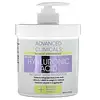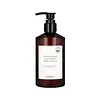What's inside
What's inside
 Key Ingredients
Key Ingredients

 Benefits
Benefits

 Concerns
Concerns

 Ingredients Side-by-side
Ingredients Side-by-side

Water
Skin ConditioningCetearyl Alcohol
EmollientParaffinum Liquidum
EmollientGlyceryl Stearate Se
EmulsifyingCocos Nucifera Oil
MaskingIsopropyl Myristate
EmollientGlycerin
HumectantButylene Glycol
HumectantCeteareth-20
CleansingButyrospermum Parkii Butter
Skin ConditioningCaprylic/Capric Triglyceride
MaskingAloe Barbadensis Leaf Juice
Skin ConditioningChondrus Crispus Extract
Skin ConditioningSodium Hyaluronate
HumectantSqualene
EmollientTocopheryl Acetate
AntioxidantBorago Officinalis Seed Oil
EmollientPunica Granatum Seed Oil
EmollientLimnanthes Alba Seed Oil
Skin ConditioningPanthenol
Skin ConditioningDisodium EDTA
Ceramide Ns
Skin ConditioningParfum
MaskingAcrylates/C10-30 Alkyl Acrylate Crosspolymer
Emulsion StabilisingPhenoxyethanol
PreservativeCaprylyl Glycol
EmollientEthylhexylglycerin
Skin ConditioningHexylene Glycol
EmulsifyingSodium Hydroxide
BufferingWater, Cetearyl Alcohol, Paraffinum Liquidum, Glyceryl Stearate Se, Cocos Nucifera Oil, Isopropyl Myristate, Glycerin, Butylene Glycol, Ceteareth-20, Butyrospermum Parkii Butter, Caprylic/Capric Triglyceride, Aloe Barbadensis Leaf Juice, Chondrus Crispus Extract, Sodium Hyaluronate, Squalene, Tocopheryl Acetate, Borago Officinalis Seed Oil, Punica Granatum Seed Oil, Limnanthes Alba Seed Oil, Panthenol, Disodium EDTA, Ceramide Ns, Parfum, Acrylates/C10-30 Alkyl Acrylate Crosspolymer, Phenoxyethanol, Caprylyl Glycol, Ethylhexylglycerin, Hexylene Glycol, Sodium Hydroxide
Water
Skin ConditioningNiacinamide
SmoothingCetyl Ethylhexanoate
Emollient1,2-Hexanediol
Skin ConditioningMethylpropanediol
SolventCaprylic/Capric Triglyceride
MaskingGlycerin
HumectantCetearyl Olivate
Sorbitan Olivate
EmulsifyingXanthan Gum
EmulsifyingSorbitan Stearate
EmulsifyingPolysorbate 60
EmulsifyingCarbomer
Emulsion StabilisingTriethanolamine
BufferingEthylhexylglycerin
Skin ConditioningSodium Acrylate/Sodium Acryloyldimethyl Taurate Copolymer
Emulsion StabilisingIsohexadecane
EmollientDisodium EDTA
Polysorbate 80
EmulsifyingSodium Hyaluronate
Humectant3-O-Ethyl Ascorbic Acid
Skin ConditioningLactic Acid
BufferingWater, Niacinamide, Cetyl Ethylhexanoate, 1,2-Hexanediol, Methylpropanediol, Caprylic/Capric Triglyceride, Glycerin, Cetearyl Olivate, Sorbitan Olivate, Xanthan Gum, Sorbitan Stearate, Polysorbate 60, Carbomer, Triethanolamine, Ethylhexylglycerin, Sodium Acrylate/Sodium Acryloyldimethyl Taurate Copolymer, Isohexadecane, Disodium EDTA, Polysorbate 80, Sodium Hyaluronate, 3-O-Ethyl Ascorbic Acid, Lactic Acid
 Reviews
Reviews

Ingredients Explained
These ingredients are found in both products.
Ingredients higher up in an ingredient list are typically present in a larger amount.
This ingredient is an emollient, solvent, and texture enhancer. It is considered a skin-softener by helping the skin prevent moisture loss.
It helps thicken a product's formula and makes it easier to spread by dissolving clumping compounds.
Caprylic Triglyceride is made by combining glycerin with coconut oil, forming a clear liquid.
While there is an assumption Caprylic Triglyceride can clog pores due to it being derived from coconut oil, there is no research supporting this.
Learn more about Caprylic/Capric TriglycerideDisodium EDTA plays a role in making products more stable by aiding other preservatives.
It is a chelating agent, meaning it neutralizes metal ions that may be found in a product.
Disodium EDTA is a salt of edetic acid and is found to be safe in cosmetic ingredients.
Learn more about Disodium EDTAEthylhexylglycerin (we can't pronounce this either) is commonly used as a preservative and skin softener. It is derived from glyceryl.
You might see Ethylhexylglycerin often paired with other preservatives such as phenoxyethanol. Ethylhexylglycerin has been found to increase the effectiveness of these other preservatives.
Glycerin is already naturally found in your skin. It helps moisturize and protect your skin.
A study from 2016 found glycerin to be more effective as a humectant than AHAs and hyaluronic acid.
As a humectant, it helps the skin stay hydrated by pulling moisture to your skin. The low molecular weight of glycerin allows it to pull moisture into the deeper layers of your skin.
Hydrated skin improves your skin barrier; Your skin barrier helps protect against irritants and bacteria.
Glycerin has also been found to have antimicrobial and antiviral properties. Due to these properties, glycerin is often used in wound and burn treatments.
In cosmetics, glycerin is usually derived from plants such as soybean or palm. However, it can also be sourced from animals, such as tallow or animal fat.
This ingredient is organic, colorless, odorless, and non-toxic.
Glycerin is the name for this ingredient in American English. British English uses Glycerol/Glycerine.
Learn more about GlycerinSodium Hyaluronate is hyaluronic acid's salt form. It is commonly derived from the sodium salt of hyaluronic acid.
Like hyaluronic acid, it is great at holding water and acts as a humectant. This makes it a great skin hydrating ingredient.
Sodium Hyaluronate is naturally occurring in our bodies and is mostly found in eye fluid and joints.
These are some other common types of Hyaluronic Acid:
Learn more about Sodium HyaluronateWater. It's the most common cosmetic ingredient of all. You'll usually see it at the top of ingredient lists, meaning that it makes up the largest part of the product.
So why is it so popular? Water most often acts as a solvent - this means that it helps dissolve other ingredients into the formulation.
You'll also recognize water as that liquid we all need to stay alive. If you see this, drink a glass of water. Stay hydrated!
Learn more about Water